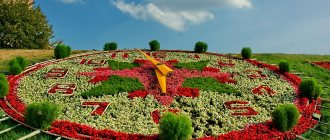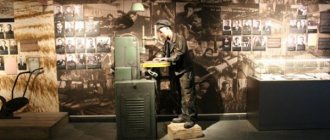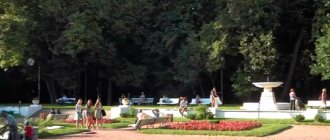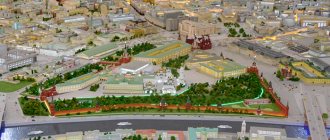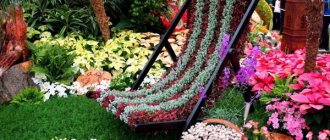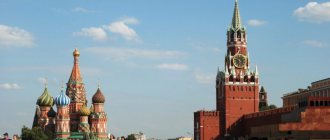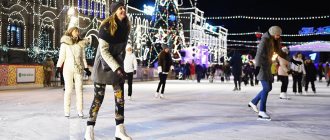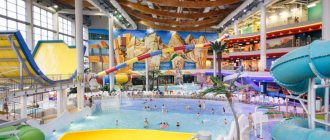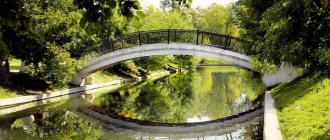Sparrow Hills is an iconic place for the capital; it is one of the “seven hills” on which Moscow arose; it has existed as a natural reserve only since 1998. In fact, this is a hill formed by the high right bank of the Moscow River, covered with a forest park, the maximum height is 220 m.
Park of Culture and Recreation "Sparrow Hills" in Moscow
Now the park is an array of broad-leaved forest, dotted with ravines that have formed small rivers, tributaries of Moscow. It is from the Sparrow Hills, the most famous observation deck in the city, that a beautiful view of Moscow opens. In Soviet times, the park was called Lenin Mountains, but the historical name returned again.
St. Andrew's Monastery
| Photo: Taday.ru |
St. Andrew's Monastery in Plennitsy is one of the oldest monasteries in Moscow. Documentary evidence from the mid-16th century (at that time the monastery was called the Preobrazhenskaya Hermitage) says that its founder was a Moscow nobleman, the okolnichy of Tsar Alexei Mikhailovich Fyodor Rtishchev. However, according to legend, the monastery has been on this site since the 13th century.
In the 17th century, the monastery housed the “Teaching Brotherhood” - essentially the first academic structure in Moscow, which united the most educated monks of that time “for the sake of book teaching.” In 1764, St. Andrew's Monastery “proved hopeless for its own maintenance” and became an ordinary parish church. An almshouse was set up in its premises, and during the plague epidemic, a cemetery for high-born citizens and residents of Moscow monasteries.
During Soviet times, the local churches were closed one after another. In 1991, services were resumed there, and in 2013, St. Andrew's Monastery reopened. Now it houses the Educational Committee and the Synodal Department for Relations of the Church with Society and the Media of the Moscow Patriarchate, as well as the Synodal Library named after His Holiness Patriarch Alexy II.
History of creation
It is believed that the park got its name from the village of Vorobyovo, which is mentioned in the chronicles; it says that in 1453, Grand Duchess Sofya Vitovtovna, the wife of Prince Vasily I, acquired the village from the Vorobyovo boyars. Later, the Vorobyovsky Palace, the main country residence of the Moscow monarchs, was built here.
Under Vasily III, the palace served as a fortress, the king hid here from the Tatar raid... in a haystack and escaped, for which he loved this palace more than his other chambers. The Vorobyovsky Palace and the lands around it were the favorite vacation spot of Grozny, Godunov and Alexei Mikhailovich. It was dismantled due to its disrepair during the time of Catherine.
Vorobyovsky Palace of the 18th century
The village of Vorobyovo is a long-liver; it existed for at least five centuries; its complete destruction was facilitated only by the construction of a large complex of the main building of Moscow State University.
On the site of the village, an observation deck was organized, next to which the Church of the Life-Giving Trinity, the only evidence of the former royal village of Vorobyovo, was preserved.
The village of Vorobyovo in the 19th century
Near the Sparrow Hills there is the St. Andrew's Monastery, built in the 16th century. After the secularization of the lands in 1764, the monastery was disbanded and converted into an almshouse. In 1991, the monastery was returned to the Russian Orthodox Church. St. Andrew's ponds were dug near the monastery, which still decorate the park.
RAS Presidium building
| Photo: Fototerra.ru |
The Russian Academy of Sciences (RAN) is the country's largest center for fundamental research. The “new building” of the Presidium of the Russian Academy of Sciences is located not far from the St. Andrew’s Monastery, at the foot of the Sparrow Hills. It was built over almost 30 years, from the late 1960s to the early 1990s. Major scientific and creative events take place here.
The roof of the building is decorated with an outlandish design reminiscent of solar panels. In reality, it has no practical use, but it is because of it that the structure was nicknamed “golden brains.”
Attractions
It makes sense to go to Vorobyovy Gory for at least two reasons: to see the sights of Moscow from a flying height and to relax in nature.
Cable car on Vorobyovy Gory
The opening of a new cable car in Moscow (Sparrow Hills - New League - Luzhniki) took place on November 26, 2021.
The total length of the cable car is 720 meters.
What can you see from above
From here you can clearly see the Moscow River and its bends, the capital's famous high-rise buildings, and the domes of large churches.
Right in the center on the opposite bank of the river is the Luzhniki Grand Sports Arena, one of the oldest stadiums in Moscow. “Luzhniki” grew up here in 1956 - a noticeable round structure and the surrounding area. Many Muscovites habitually use it as a landmark when looking at various objects of the panorama from the Vorobyovy Gory site.
For example, the very left point from Luzhniki is the modern Moscow skyscrapers “Moscow City” with their luxurious business centers and luxury residential complexes. To the right of Moscow City you can see the Ukraine Hotel, the unchanged spire - the Ostankino TV Tower, and even further - the White House (the building that houses the Russian government). Here, to the left of Luzhniki, you can find two famous “Stalinist high-rise buildings”: one of them is a house on Kudrinskaya Square, the other is the Russian Foreign Ministry. In the space between the high-rise buildings it is easy to find New Arbat with its book-shaped houses and the building of the Novodevichy Convent.
From the observation deck you can clearly see several embankments - Novodevichy and Berezhkovskaya, Vorobyovskaya and Luzhnetskaya, and the bridges connecting them.
Right behind the stadium, the multi-colored domes of St. Basil's Cathedral stand out, part of the Kremlin bell towers, and the power of the Cathedral of Christ the Savior are visible. Here you can also see another landmark of modern Moscow - the huge figure of Peter I, installed on the Red October Spit, a very odious work by Zurab Tsereteli. Right there in the gap is the third “Stalinist skyscraper” - near the Red Gate, and the famous Sechenov Medical University.
If you move from the central part of the panorama to the right, you can immediately see the fourth “high-rise” - the house on Kotelnicheskaya, the oldest residential complex on the embankment, living in which in the middle of the last century was a sign of special elitism. The house is familiar to many - it played an important role in the popular Soviet film “Moscow Doesn’t Believe in Tears.”
© Natalya Shelpova
If you move your gaze further, it is difficult to miss the Shukhov TV Tower - an engineering project of incredible courage and implementation, created in the 20s of the last century. At the moment, the tower is practically not used for its intended purpose and is left as a historical monument.
Even further to the right you can find in the panorama the Presidium of the Academy of Sciences - a 22-story high-rise building built in the 1990s.
In a word, it’s difficult to even name another place other than the observation deck on Sparrow Hills, from where you can see so many of the capital’s attractions at once and understand how they relate to each other.
Panoramic view of Moscow from the observation deck on Sparrow Hills - Google Maps
Sights of Sparrow Hills
If you get to the observation deck, be sure to check out the interesting places around. First of all, of course, the territory of Moscow State University - still the main stronghold of science and classical education in Russia. The main building of Moscow State University (it’s hard to miss, it dominates the entire space around) has its own observation deck. The site is located at an altitude of 200 meters (24th floor). True, you won’t be able to get there for free - access is only allowed as part of an excursion group.
Here on the Sparrow Hills you can see the St. Andrew's Monastery.
For nature lovers, the territory of the Sparrow Hills is almost ideal: there is a botanical garden of Moscow University, the Moscow River embankment, Andreevsky Pond, many pleasant paths and routes: no matter which direction you go, there is great walking everywhere.
© Natalia Konnova
House-Museum of Pyotr Leonidovich Kapitsa
| Photo: Museum.ru |
One of the founders of the Moscow Institute of Physics and Technology, the first head of the Department of Low Temperature Physics of the Faculty of Physics of Moscow State University, Pyotr Kapitsa discovered the phenomenon of superfluidity of liquid helium and developed a high-performance industrial installation for liquefying gases (turboexpander). In 1978 he won the Nobel Prize in Physics.
Kapitsa has lived in a house on Kosygina Street for the last 28 years. The museum is located on the territory of the Institute of Physical Problems, which the scientist founded and whose director remained until the last days of his life. You can visit the museum only by appointment.
Description of the area
Andreevskie Ponds (Saratov) are not alone. There are many more interesting places nearby.
The ponds are protected from cold winds by the Savelyevsky Mountains. You can climb to the highest point of the mountains, called Pioneer Peak, directly from the ponds. It is located at an altitude of 290 meters above sea level. The slopes of the mountain are popularly called Switzerland.
The climb can be quite challenging. But the view from the top is worth it. It allows you to view the suburban areas of Saratov, ponds and a forested area called Kumysnaya Polyana.
Andreevsky Ponds (Saratov) are connected with the Forester's Glade and the Giant Oak. To do this, just walk along the path along the ravine.
Not far away there is a place where Weymouth pines grow, having soft long needles and cones of an original shape.
Vasilievskoye Estate (Mamonova Dacha)
| Photo: Ru.moscow365.com |
The so-called Mamonova dacha - the former Vasilyevskoye estate - belonged successively to princes Vasily Mikhailovich Dolgorukov-Krymsky, Nikolai Borisovich Yusupov and Count Matvey Aleksandrovich Dmitriev-Mamonov, after whose last name it was named.
Its current address is Kosygina Street, 4. The mansion was built in the 1730s, and acquired its current Empire appearance only 100 years later, under Prince Yusupov. Then a domed hall for balls and receptions was built over the central volume, and belvederes in the form of turrets were built over the side ones. The estate was famous for its orchards and greenhouses, from where “red, white and green watermelons, various kinds of best-tasting melons and cantaloupes, as well as many other rare fruits” came to the table of Muscovites.
At the end of the 19th century, a psychiatric hospital was located here, and then a floriculture farm built on the basis of Yusupov’s greenhouses. In 1910, the building was purchased by the Moscow City Duma to establish a public park here.
In 1923-1943, the Central Museum of Ethnic Studies was located in the estate. A unique exposition of the dwellings of the peoples of Russia was located right in the park, in the open air. During the war, the museum was closed, and the building became the property of the Institute of Chemical Physics; the upper estate park was occupied by the Institute of Physical Problems. In addition to institute buildings, there were mansions of the party leadership, where, for example, Alexey Kosygin and Mikhail Gorbachev lived.
Now only the lower part of the park is open to the public.
Springboard and metro bridge
| Photo: RIA Novosti |
The ski jump on Vorobyovy Gory (now under reconstruction) was built back in 1953. Even then it was an illuminated ski slope with a 340-meter-long chair lift.
And five years later, the Luzhnetsky metro bridge was built, connecting Vorobyovy Gory and Luzhniki. The metro station “Leninskie Gory” (after 1999 - “Sparrow Hills”) is located on it, and next to the exit from the metro there is an escalator leading to Kosygina Street (now it is in ruins).
Opening hours and ways to get there
The park is open 24 hours a day. Park address: Michurinsky Prospect, 13. Sparrow Hills are located not far from the center, the main difficulty is their length, so be prepared to walk a lot.
The easiest way to get to the park is to take the Sokolnicheskaya line to the station. m. "Sparrow Hills". To get to the park you need to go towards Kosygina Street and then turn right onto Vorobyovskaya Embankment and walk along it for 15–20 minutes. and then go up to the observation deck.
You can also get to the site by trolleybus No. 7 from the station. metro station "Kyiv" or "Park Pobedy" (both on the Arbatsko-Pokrovskaya line).
Nature reserve "Sparrow Hills"
| Photo: Taday.ru |
In 1987, the Vorobyovy Gory (at that time - Leninsky) was declared a natural monument, and in 1998 a state nature reserve was created, declared a specially protected natural area.
The high and steep slopes of the Moscow River valley are dissected by deep gullies. This creates a risk of landslides, so there has been no intensive development in the area. The natural appearance of the reserve has been completely preserved. Today, Vorobyovy Gory is the only specially protected natural area of Moscow near the city center, where a natural broad-leaved forest with its flora and fauna has been preserved.
Linden, oak, maple, birch and ash trees grow here: the roots of the trees secure the steep slopes from erosion. In the park there are lilies of the valley, bluebells, and lungwort. Among them live squirrels and moles, nightingales and warblers, long-eared owls, ravens and gray owls. They say that sometimes in the sky above the reserve you can see a falcon, sparrowhawk, and kestrel.
The reserve offers excursions with almost tame animals and birds, and three ecological trails have been developed. There is also a forest pond on the terraces of the Sparrow Hills.
In addition, on the territory of the reserve there is a monument marking the place of the oath of Alexander Herzen and Nikolai Ogarev to continue the work of the Decembrists and sacrifice their lives for the sake of their chosen struggle.
Sports and entertainment on Vorobyovy Gory
Vorobyovy Gory Park is of interest primarily to sports fans. In summer it becomes a center of attraction for cyclists and rollerbladers. Along the embankment of the Moscow River there is a path with a good asphalt surface. On the embankment in hot sunny weather, many people sunbathe.
And for winter sports lovers, during the cold season there is the Vorobyovy Gory active park - a ski base with a ski lift, rental of skis, snowboards and sleighs.
From the park you can take the chairlift up to the observation deck, which offers views of the Moscow River, Luzhniki Stadium, Moscow City skyscrapers, Shukhov Tower, Novodevichy and St. Andrew's monasteries.
The Vorobyovy Gory ski slope deserves special mention ; its main advantage is its location. You can get here on foot from the nearest metro station. In the dark, the tracks are illuminated.
The ski slopes have three slopes of different lengths, their length is 230 m, the height difference is 50 m, the degree of difficulty allows both professionals, amateurs and beginners to enjoy.
Young athletes from the Vorobyovy Gory sports school can train on the training slope, and experienced instructors will provide all the necessary assistance.
But still, the main type of active recreation in the park is walking; the park’s territory, long and rugged, will provide sufficient physical activity even for trained “pedestrians.” Walking here is very pleasant, because on the slopes there is a native broad-leaved forest, where oaks, lindens, ash, rowan, alder, and elm grow.
Powerful root systems of trees anchor steep slopes and prevent rain and melt water from eroding fertile soil. The most common shrubs are honeysuckle, euonymus, raspberry, as well as spirea, lilac, and snowberry planted here. Among the animals you can meet and feed squirrels, among the birds you can hear owls, cuckoos, woodpeckers and black grouse.
For family visitors, active recreation is available on the playgrounds and sports grounds of Vorobyovy Gory; there is even a football field in the park. In winter, in addition to going down the slopes and hills on skis, snowboards and cheesecakes, there is also a cross-country ski track.
For animal lovers, there is a mini-zoo on the mountains with birds: chickens, pheasants, peacocks. Nearby there is a vending machine where you can buy special food for birds and food for squirrels.
Embankments of Vorobyovy Gory
| Photo: Taday.ru |
On two embankments located to the right and left of the metro bridge - Vorobyovskaya and Andreevskaya - you can rent bicycles, roller skates, and skateboards. Some Muscovites go jogging along the Moskva River - from the Third Ring Road to Gorky Park.
On the embankments you can dine in cozy cafes and sunbathe in the summer. Fishermen and couples love to sit on Andreevskaya Embankment, but swimming here is not recommended.
Vorobyovy Gory on the map
Vorobyovy GoryPark of Culture and Leisure in Moscow
- Tours to Cuba for 9-11 nights, 2 adults + 1 child, 3-5* hotels, all inclusive from 153,322 rubles for THREE – October
- Kul-Sharif Mosque in Kazan
- Weather in Thailand in August
- Royal Palace in Amsterdam
- 17 best beaches in Adler
- Anapa hotels all inclusive
- Villa Adriana in Tivoli
- Where to relax by the sea in October - 15 best destinations
- Weather in Thailand in March
- Baro de Cuadras Palace opens in Barcelona
- Tours to Turkey for 9-11 nights, 1 adult + 1 child, 4 and 5* hotels, all inclusive from 50,207 rubles for TWO – May
- Hotels in Turkey without children
+2
Church of the Life-Giving Trinity on Vorobyovy Gory
| Photo: Panoramio.com |
A wooden church existed here already in 1453, when Princess Sophia bought the village. The current building of the temple began to be built in 1811 in the style of late classicism. Quadrangular, with portals decorated with columns, it is a single-domed temple with a two-tier bell tower. In place of the altar of the old temple, a white stone monument topped with a cross was erected, which has survived to this day.
In 1812, Field Marshal Mikhail Kutuzov prayed here before the council in Fili. The temple survived the Napoleonic invasion and was not closed even during Soviet times: both the external appearance and the interior of the church were completely preserved.
Observation deck
| Photo: Anddrive.ru |
For centuries, the Sparrow Hills were the place from which conquerors looked at Moscow. An observation deck for civilians was built in 1948. Today it is popular not only among tourists and newlyweds: for example, motorcyclists and racing drivers gather here. From here you can take panoramic photos of the city, there are excursions and dance performances.
Main building of Moscow State University
| Photo: Msu.mnc.ru |
In 1947, Joseph Stalin ordered the construction of eight high-rise buildings in Moscow, the largest of which was to be the new building of Moscow State University.
The height of the building is 182 meters, and with the spire - 240 meters. It is designed in such a way that the inhabitants may not leave it for weeks or even months. The central building of 36 floors contains classrooms, an assembly hall and a cultural center; in the two side buildings and the four adjacent “sails” there are dormitories for undergraduate and graduate students, and in the four turrets that close the “sails” there are apartments for teachers. At their service are libraries with reading rooms, a post office, a telegraph office, canteens, food and manufactured goods stores, a hairdresser, consumer services enterprises, a clinic, a sports center with a 25-meter swimming pool and even their own police department.
The first project of the Moscow State University was developed by Boris Iofan, who had previously worked on another architectural “giant” - the never-built Palace of the Soviets on the site of the Cathedral of Christ the Savior. It is easy to see that some ideas passed from the palace to the university. However, Iofan was again unable to implement them: due to disagreements, the design was transferred to a group of architects led by Lev Rudnev.
Excavation work began in 1948, laying the first stone on April 12, 1949. In March 1951, Stalin endorsed the architectural and planning assignment for the construction of roads and landscaping of the areas adjacent to the future building. The work was supervised by Lavrentiy Beria - the labor of several thousand prisoners was used in the construction. The grand opening of the Main Building of Moscow State University took place on September 1, 1953, after Stalin’s death.
Landscapes and architecture of the park
The park has three historical ponds and many springs. The park stretches in a semicircle along the river for 10 km, encircling the Luzhniki ensemble, from the mouth of the Setun River to the St. Andrew's Bridge, covering an area of more than a thousand hectares.
Five restored and beautifully decorated springs, where the river beds have been cleared, paths laid, and benches installed, can also be considered a decoration of the park. Visitors to the park can now enjoy the babbling of spring water, but drinking the water is not recommended.
One of the sources is located next to the monument, which was erected to two young students. Here, on the Sparrow Hills, the future publicist and philosopher Alexander Herzen and his friend, poet and writer Nikolai Ogarev, looking at Moscow from above, took an oath to devote their lives to the struggle for the happiness of the Fatherland.
The Church of the Life-Giving Trinity stands not far from the site; it was built at the beginning of the 19th century in the Empire style on the site of earlier wooden churches.
There are many interesting objects near the Sparrow Hills. One of the most ancient is St. Andrew's Monastery , built in the 16th century.
The heyday of the monastery came at the end of the 17th century, when the “Teaching Brotherhood” was located within its walls, uniting the most educated monks of that time “for the sake of book teaching.” The “Brotherhood” subsequently laid the foundation for the Slavic-Greek-Latin Academy, becoming, in fact, the first higher educational institution in Russia.
Even the Vorobyovy Gory metro station is the only station of its kind on the bridge. Today it is the longest station of the Moscow metro (234 m). The pedestrian part of the bridge and the station lobby offer a wonderful view of the Moscow River and Sparrow Hills, and thematic exhibitions are held at the station itself.
There is a place in the park that everyone calls “ Mamonova Dacha .” The history of this strange name goes back centuries. Next to the St. Andrew's Monastery was the Vasilievskoye estate, which during the first Romanovs belonged to the most noble families - first the Saltykovs, then the Dolgorukovs.
A luxurious estate with a large stone house with mezzanines (this composition as a whole has been preserved) was built on this site by the famous commander V.M. Dolgorukov-Krymsky, winner of the Turks, hero of Ochakov and Perekop.
The estate had a beautiful regular park and an orchard with a greenhouse, two ponds, gazebos, Turkish-style pavilions, and models of Turkish fortresses built on the occasion of the reception of Catherine II in 1780.
Vasilyevskoye under the Dolgorukovs was open to guests; balls and receptions were held here with dinners and fireworks. Everything changed in 1831, when Matvey Dmitriev-Mamonov became the owner of the estate, who during the War of 1812 became famous for the fact that he formed an entire regiment at his own expense and, with the rank of major general, commanded it in military operations.
After his retirement, the count showed the first signs of mental illness. He lived as a complete recluse; servants served him drink, food and clothing in his absence and received orders in writing. M.A. died Dmitriev-Mamonov is here after almost thirty years of actual imprisonment at the age of 73. Since then, the Vasilyevskoye estate began to be called “Mamonova Dacha”.
Later, the estate was both a hospital and a public park. In 1924, Russia’s first “Museum of Ethnic Studies” (ethnography) with an interesting exhibition was located here, but after the war the museum moved to Leningrad, and Mamonova’s dacha again became an object closed from prying eyes.
The Institute of Chemical Physics, headed by N. Semenov, Nobel Prize laureate, is located here. In 1937–1950, buildings were built in the Mamonova Dacha Park, which now houses the Institute of Physical Problems of the Russian Academy of Sciences. P.L. Kapitsa . On the walls of the institute hang memorial plaques stating that the great physicists of the 20th century, academicians, Nobel laureates P.L. lived and worked here. Kapitsa and L.D. Landau.
Only the lower part of the park is open to the public. Currently, the main buildings of the estate - the main house, the greenhouse and the linden park - are protected by the state as valuable natural and architectural monuments.
On the territory of Mamonova Dacha, a linden alley has been preserved to this day, the trees of which are more than 250 years old. The shape and location of some alleys remain the same as many years ago.
Perhaps the most famous building on Sparrow Hills is the Main Building of Moscow State University . Or rather, it is a whole ensemble - in front of the building there is a monument to the founder of the university - Mikhail Lomonosov. There is a pond with fountains nearby. Along it is an alley with busts of great scientists.
There is a park on both sides of the high-rise building. In 1947, a plan arose in high government circles to build eight high-rise buildings in Moscow, the largest of which was to be the new building of Moscow State University. The authors of the project are a group of architects led by L. Rudnev.
The height of the building is 182 m, and with the spire - 240 m. Until 1990, Moscow State University was the tallest building in Europe. As you know, the first idea for the high-rise belonged to the famous Soviet architect Iofan (the author of the Palace of the Soviets project); he planned to build the building right next to the cliff (on the site of the observation deck), but, fearing landslides, they chose a different project.
The building is designed in such a way that the inhabitants may not leave it for weeks or even months. The central building of 36 floors houses classrooms, an assembly hall and a House of Culture. In the two side buildings and the four adjacent “sails” there are dormitories for undergraduate and graduate students, and in the four turrets that close the “sails” there are apartments for teachers.
At their service are libraries with reading rooms, a post office, a telegraph office, canteens, food and manufactured goods stores, a hairdresser, consumer services enterprises, a clinic, a sports center with a 25-meter swimming pool and even their own police department.

